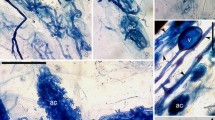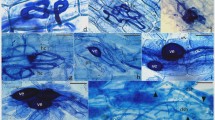Abstract
Roots of salt marsh plant speciesSpartina alterniflora, S. patens, Distichlis spicata, and others were examined for the presence of vesicular-arbuscular mycorrhizal (VAM) fungi. Samples were taken from introduced planted material in a salt marsh restoration project and from native material in adjacent marsh areas along the Indian River, Clinton, Connecticut, USA. After ten years the replanted area still has sites devoid of vegetation. The salt marsh plants introduced there were devoid of VAM fungi, while high marsh species from the adjacent undisturbed region showed consistent infection, leading the authors to suggest that VAM fungal infection of planting stocks may be a factor in the success of marsh restoration.
Similar content being viewed by others
Literature Cited
Aldon, E. F. 1978. Endomycorrhizae enhance shrub growth and survival on mine spoils. Pages 174–179,In R. A. Wright (ed.), The reclamation of disturbed arid lands. University of New Mexico Press, Albuquerque, New Mexico.
Allen, E. B., and M. F. Allen. 1980. Natural re-establishment of vesicular-arbuscular mycorrhizae following strip mine reclamation in Wyoming.Journal of Applied Ecology 17:139–147.
Allen, E. B., and G. L. Cunningham. 1983. Effects of vesicular-arbuscular mycorrhizae onDistichlis spicata under three salinity levels.New Phytologist 93:227–236.
Allen, H. H., E. J. Clairain, Jr., R. J. Diaz, A. W. Ford, L. J. Hunt, and B. R. Wells. 1978. Habitat development field investigations, Bolivar Peninsula, marsh and upland habitat development site, Galveston Bay, Texas (summary report). Technical Report D-78-15. US Army Engineer Waterways Experiment Station. Vicksburg, Mississippi.
Allen, M. F. 1982. Influence of vesicular-arbuscular mycorrhizae on water movement throughBouteloua gracilis (H.B.K.) Lag. ex Steud.New Phytologist 91(2):191–196.
Allen, M. F. and E. B. Allen. 1986. Utah state project examplifies restoration ecology approach to research.Restoration and Management Notes 4(2):64–67.
Barrow, N. J., N. Malajczuck and T. C. Shaw. 1977. A direct test of the ability of VAM to help plants take up fixed soil phosphate.New Phytologist 78:269–276.
Bradley, R., A. J. Burt and D. J. Read. 1982. The role of mycorrhizal infection in heavy metal resistance.New Phytologist 91:197–210.
Busse, M. E. and J. R. Ellis. 1985. Vesicular-arbuscular mycorrhizal (Glomus fasciculatum) influence on soybean drought tolerance in high phosphorus soil.Canadian Journal of Botany 63:2290–2294.
Chaubal, R., G. D. Sharma, and R. R. Mishna. 1982. VAM in subtropical aquatic and marshy plant communities.Proceedings of the Indian Academy of Science 91:67–77.
Cooper, K. M., and P. B. Tinker. 1978. Translocation and transfer of nutrients in vesicular-arbuscular mycorrhizas. II. Uptake and translocation of phosphorus, zinc, and sulfur.New Phytologist 81:43–52.
Daft, M. J., and E. Hacskaylo. 1977. Growth of endomycorrhizal and nonmycorrhizal red maple seedlings in sand and anthractie spoil.Forest Science 23(2):207–216.
Daft, M. J., E. Hacskaylo, and T. H. Nicolson. 1975. Arbuscular mycorrhizas in plants colonising coal spoils in Scotland and Pennsylvania. Pages 561–580In F. E. Sanders, B. Mosse, and P. B. Tinker (eds.), Endomycorrhizas. Academic Press, London.
Gildson, A., and P. B. Tinker. 1983. Interactions of VAM infection and heavy metals in plants. I. The effects of heavy metals of VAM development.New Phytologist 95(2):247–262.
Gould, A. B., and A. E. Liberta. 1981. Effects of topsoil storage during surface mining on the viability of vesicular-arbuscular mycorrhiza.Mycologia 73(5):914–922.
Graw, D. 1979. The influence of soil pH on the efficiency of VAM.New Phytologist 82(3):687–696.
Hasted, S. 1979. Experiments in saltmarsh restoration: Clinton and Stratford, Connecticut. Working Paper No. 3, Area Cooperative Education Service, New Haven, Connecticut 166 pp.
Harley, J. L., and S. E. Smith. 1983. Mycorrhizal symbiosis. Academic Press, New York. 483 pp.
Harris, J. A., D. Hunter, P. Birch and K. C. Short. 1987. Vesicular-arbuscular mycorrhizal populations in stored topsoil.Transactions of the British Mycological Society 89(4):600–603.
Hayman, D. S., and M. Tavares. 1985. Plant growth responses to vesicular-arbuscular mycorrhiza. XV. Influence of soil pH on the symbiotic efficiency of different endophytes.New Phytologist 100:367–377.
Hetrick, B. A., and J. Bloom. 1983. Vesicular-arbuscular mycorrhizal fungi associated with native tall grass prairie and cultivated winter wheat.Canadian Journal of Botany 61:2140–2146.
Hetrick, B. A. D., W. W. Bockus, and J. Bloom. 1984. The influence of temperature on colonization of winter wheat by vesicular-arbuscular mycorrhizal fungi.Mycologia 76(5):953–956.
Hill, D. E., and A. E. Shearin. 1970. Tidal marshes of Connecticut and Rhode Island. Connecticut Agricultural Experiment Station, New Haven, Connecticut. Bulletin 709. 34 pp.
Ho, I. 1987. Vesicular-arbuscular mycorrhizae of halophytic grasses in the Alvord Desert of Oregon.Northwest Science 61(3):148–151.
Janick, J., R. W. Schery, F. W. Woods, and V. W. Ruttan. 1981. Plant science—an introduction to world crops, 3rd ed. W. H. Freeman and Company, San Francisco. 868 pp.
Keeley, J. E. 1980. Endomycorrhizae influence growth of blackgum seedlings in flooded soils.American Journal of Botany 67(1):6–9.
Khan, A. G. 1974. The occurrence of mycorrhizas in halophytes, hydrophytes and xerophytes and ofEndogone spores in adjacent soils.Journal of General Microbiology 81:7–14.
Kormanik, P. P., and A.-C. McGraw. 1982. Quantification of vesicular-arbuscular mycorrhizae in plant roots. Pages 37–45In N. C. Schenck (ed.), Methods and principles of mycorrhizal research. The American Phytopathological Society, St. Paul, Minnesota.
Kormanik, P. P., W. C. Bryan, and R. C. Schultz. 1980. Procedures and equipment for staining large numbers of plant root samples for endomycorrhizal assay.Canadian Journal of Microbiology 26:536–538.
Le Tacon, F., F. A. Skinner, and B. Mosse. 1983. Spore germination and hyphal growth of a vesicular-arbuscular mycorrhizal fungusGlomus mosseae (Gerdemann & Trappe) under decreased oxygen and increased carbon dioxide concentrations.Canadian Journal of Microbiology 29:1280–1285.
Liberta, A. E., R. C. Anderson, and Z. A. Dickman. 1983. Vesicular-arbuscular mycorrhiza fragments as a means of endophyte identification at hydrophytic sites.Mycologia 75(1):169–171.
Linderman, R. G., and J. W. Hendrix. 1982. Evaluation of plant response to colonization by vesicular-arbuscular mycorrhizal fungi. A. Host variables. Pages 69–76In N. C. Schenck (ed.), Methods and principles of mycorrhizal research. The American Phytopathological Society, St. Paul, Minnesota.
Marshall, P. E., and N. Pattullo. 1981. Mycorrhizae occurrence in willows in a northern freshwater wetland.Plant and Soil 59(3):465–471.
Masson, E. 1928. Note on the presence of mycorrhizae in the roots of salt marsh plants.New Phytologist 28:193–195.
Miller, R. M. 1979. Some occurrence of vesicular-arbuscular mycorrhizae in natural and disturbed ecosystems of the Red Desert.Canadian Journal of Botany 57:619–623.
Miller, R. M., and J. D. Jastrow. 1986. Influence on soil structure supports agricultural role for prairies, prairie restoration.Restoration and Management Notes 4(2):62–63.
Miller, R. M., B. A. Carnes, and T. B. Moorman. 1985. Factors influencing survival of vesicular-arbuscular mycorrhizal propagules during topsoil storage.Journal of Applied Ecology 22:259–266.
Patrick, K. L. 1979. Fungi growth stimulants to play key role in future forest regeneration.Pulp and Paper 53(6):150–153.
Pennington, J. C. 1986. Feasibility of using mycorrhizal fungi for enhancement of plant establishment on dredged material disposal sites: A literature review. Miscellaneous Paper D-86-3. US Army Engineer Waterways Experiment Station, Vicksburg, Mississippi
Perry, D. A., M. P. Amaranthus, J. G. Borchers, S. L. Borchers, and R. E. Brainerd. 1989. Bootstrapping in ecosystems.Bioscience 39(4):230–237.
Phillips, J. M., and D. S. Hayman. 1970. Improved procedures for clearing roots and staining parasitic and vesicular-arbuscular mycorrhizal fungi for rapid assessment of infection.Transactions of the British Mycological Society 55:158–161.
Read, D. J., H. K. Koucheki, and J. Hodgson. 1976. Vesicular-arbuscular mycorrhiza in natural vegetation systems. I. The occurrence of infection.New Phytologist 77:641–653.
Reeves, F. B., D. Wagner, T. Moorman, and J. Kiel. 1979. The role of endomycorrhizae in the revegetation practices in the semi-arid West. I. A comparison of incidence of mycorrhizae in severely disturbed vs natural environments.American Journal of Botany 66:6–13.
Rives, C. S., M. I. Bajwa, A. E. Liberta, and R. M. Miller. 1980. Effects of topsoil storage during surface mining on the viability of V.A. mycorrhiza.Soil Science 129:253–257.
Schramm, J. R. 1966. Plant colonization studies on black wastes from anthracite mining in Pennsylvania.Transactions of the American Philosophical Society 56:1–194.
Sondergaard, M., and S. Laegaard. 1977. Vesicular mycorrhiza in some aquatic vascular plants.Nature (London) 268:232–233.
Timmer, L. W., and R. F. Leyden. 1980. The relationship of mycorrhizal infection to phosphorus-induced copper deficiency in sour orange seedlings.New Phytologist 85:12–23.
Author information
Authors and Affiliations
Rights and permissions
About this article
Cite this article
Cooke, J.C., Lefor, M.W. Comparison of vesicular-arbuscular mycorrhizae in plants from disturbed and adjacent undisturbed regions of a coastal salt marsh in Clinton, Connecticut, USA. Environmental Management 14, 131–137 (1990). https://doi.org/10.1007/BF02394027
Issue Date:
DOI: https://doi.org/10.1007/BF02394027




